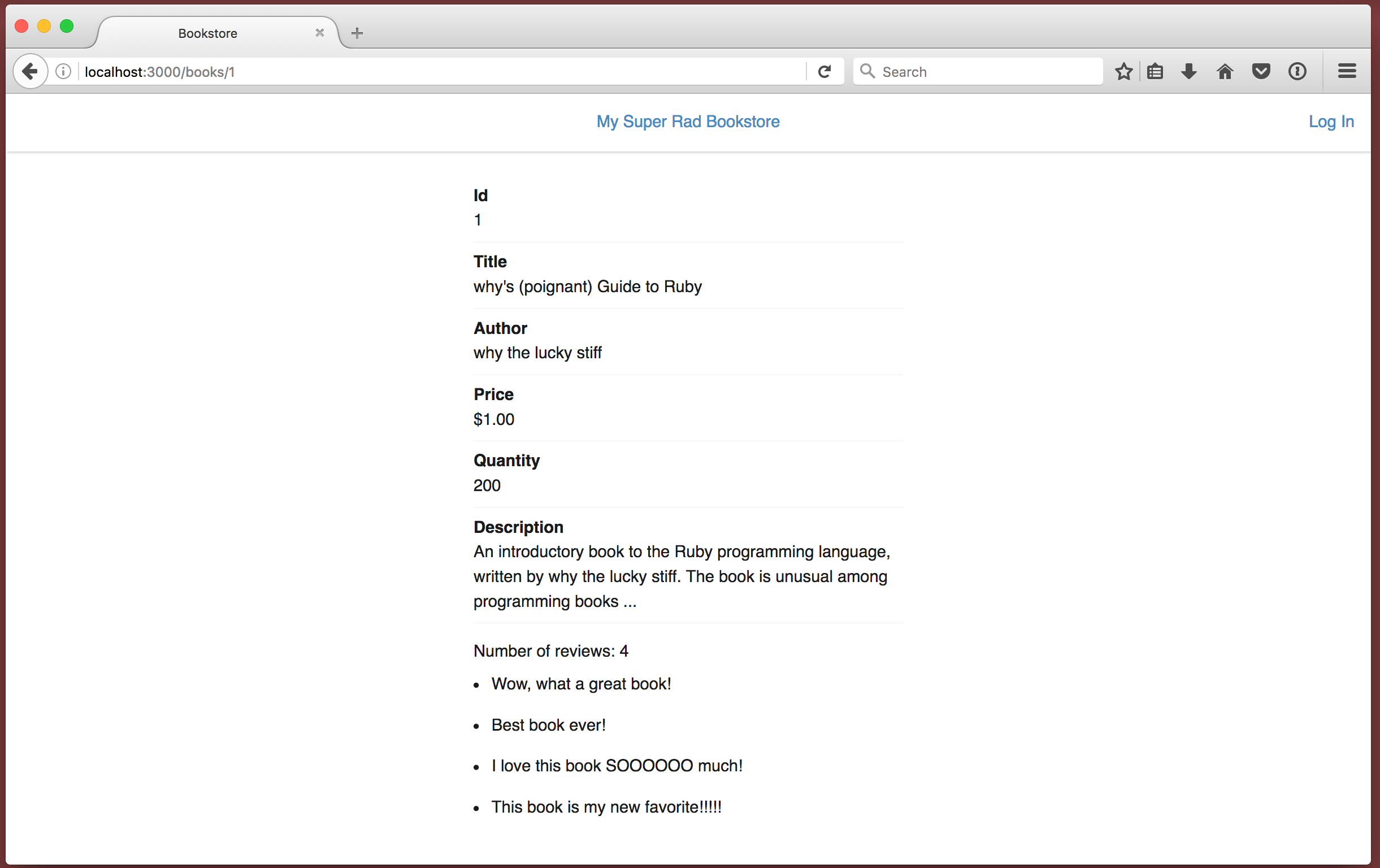Logged In vs Logged Out Users
You’re logged out, but isn’t it a little weird that you still see the “Log Out” link?

Let’s change that! We’ll only show the “Log Out” link to users who are logged in.
How Do We Know If a User is Logged In or Not?
If we only want to show the “Log Out” link to logged in users, we first have to figure out if a user is logged in or not. Fortunately, we already have the parts in place to figure this out.
After a user successfully logs in, you’re saving their user id in the session. You did this in the SessionsController create method.
def create
user = User.find_by(username: params[:session][:username])
if user && user.authenticate(params[:session][:password])
...
session[:user_id] = user.id
...
else
...
end
end
When a user logs out, you remove their user id from the session. You did this in the SessionsController destroy method.
def destroy
session[:user_id] = nil
...
end
We can tell if a user is logged in or not by checking in the session. If a user id is present, we know that user is logged in. Otherwise, no one is logged in.
We’ve only used the session in your controllers, but it’s also avaialble in your templates. Let’s see what we can do with it.
Before we get to far, you’ll need to log in again.
-
Open Terminal and go to the
bookstoredirectory. -
Now, start you application’s web server.
-
Go to http://localhost:3000/session/new and log in as “CatPower” with password “password”.
› pwd
/Users/alimi/Projects/bookstore
› rails server
=> Booting Puma
=> Rails 5.0.0.1 application starting in development on http://localhost:3000
Now that you’re logged in, we can start making some changes 😊
-
Open
app/views/layouts/application.html.erb. -
Above the “Log Out” link, add the following line:
<p> Hi, my user id is <%= session[:user_id] %> </p>The same session hash you used in the
SessionsControlleris also available here in this template.With this change, you’re going to show what user id is saved in the session. Since you’re logged in as “CatPower”, it’s going to show CatPower’s user id.
-
Save your changes and revist http://localhost:3000.
1
2
3
4
5
6
7
8
9
10
11
12
13
14
15
16
17
18
19
20
21
22
23
24
25
26
27
28
29
30
31
32
33
34
35
36
37
38
<!DOCTYPE html>
<html>
<head>
<title>Bookstore</title>
<%= csrf_meta_tags %>
<%= stylesheet_link_tag 'application', media: 'all', 'data-turbolinks-track': 'reload' %>
<%= javascript_include_tag 'application', 'data-turbolinks-track': 'reload' %>
</head>
<body>
<div class="navigation">
<div class="left">
</div>
<div class="center">
<%= link_to "My Super Rad Bookstore", root_path %>
</div>
<div class="right">
<p> Hi, my user id is <%= session[:user_id] %> </p>
<%= link_to "Log Out", session_path, method: :delete %>
</div>
</div>
<% if flash[:notice] %>
<p class="notice"> <%= flash[:notice] %> </p>
<% end %>
<% if flash[:alert] %>
<p class="alert"> <%= flash[:alert] %> </p>
<% end %>
<div class="container">
<%= yield %>
</div>
</body>
</html>

Sweet! Now that we know how to access the session in your templates, let’s put it to use.
-
Reopen
app/views/layouts/application.html.erb. -
Change the “Log Out” link and its parent
divfrom<div class="right"> <p> Hi, my user id is <%= session[:user_id] %> </p> <%= link_to "Log Out", session_path, method: :delete %> </div>to
<div class="right"> <% if session[:user_id].present? %> <%= link_to "Log Out", session_path, method: :delete %> <% else %> I'm not logged in <% end %> </div>If a
user_idis set in the session, we’ll show the “Log Out” link. Otherwise, we’ll just show “I’m not logged in”. -
Save your changes and revisit http://localhost:3000. Log out and you should no longer see the “Log Out” link.
1
2
3
4
5
6
7
8
9
10
11
12
13
14
15
16
17
18
19
20
21
22
23
24
25
26
27
28
29
30
31
32
33
34
35
36
37
38
39
40
41
<!DOCTYPE html>
<html>
<head>
<title>Bookstore</title>
<%= csrf_meta_tags %>
<%= stylesheet_link_tag 'application', media: 'all', 'data-turbolinks-track': 'reload' %>
<%= javascript_include_tag 'application', 'data-turbolinks-track': 'reload' %>
</head>
<body>
<div class="navigation">
<div class="left">
</div>
<div class="center">
<%= link_to "My Super Rad Bookstore", root_path %>
</div>
<div class="right">
<% if session[:user_id].present? %>
<%= link_to "Log Out", session_path, method: :delete %>
<% else %>
I'm not logged in
<% end %>
</div>
</div>
<% if flash[:notice] %>
<p class="notice"> <%= flash[:notice] %> </p>
<% end %>
<% if flash[:alert] %>
<p class="alert"> <%= flash[:alert] %> </p>
<% end %>
<div class="container">
<%= yield %>
</div>
</body>
</html>

Progress!
Now that we aren’t showing the “Log Out” link to logged out users, let’s show them a “Login” link instead.
-
In
app/views/layouts/application.html.erb, replace “I’m not logged in” with a link labeled “Login”. The link should go to thenew_sessionpath.Use the other links in the template as examples.
-
What does your link look like? It should look something like this:
<%= link_to "Log In", new_session_path %> -
If you didn’t already, add the “Log In” link. Save your changes, revist http://localhost:3000, and try logging in!
1
2
3
4
5
6
7
8
9
10
11
12
13
14
15
16
17
18
19
20
21
22
23
24
25
26
27
28
29
30
31
32
33
34
35
36
37
38
39
40
41
<!DOCTYPE html>
<html>
<head>
<title>Bookstore</title>
<%= csrf_meta_tags %>
<%= stylesheet_link_tag 'application', media: 'all', 'data-turbolinks-track': 'reload' %>
<%= javascript_include_tag 'application', 'data-turbolinks-track': 'reload' %>
</head>
<body>
<div class="navigation">
<div class="left">
</div>
<div class="center">
<%= link_to "My Super Rad Bookstore", root_path %>
</div>
<div class="right">
<% if session[:user_id].present? %>
<%= link_to "Log Out", session_path, method: :delete %>
<% else %>
<%= link_to "Log In", new_session_path %>
<% end %>
</div>
</div>
<% if flash[:notice] %>
<p class="notice"> <%= flash[:notice] %> </p>
<% end %>
<% if flash[:alert] %>
<p class="alert"> <%= flash[:alert] %> </p>
<% end %>
<div class="container">
<%= yield %>
</div>
</body>
</html>

If you’re anything like me, you probably tried to log out just as soon as you logged in so you could see the link change back and forth.

But if you’re not like me, give it a try! You’ve got to appreciate the small things in life 😝
You might also notice that the “Log Out”/”Login” links are on every page of your bookstore.
app/views/layouts/application.html.erb is the main layout file of your application, and it’s used by every template in your bookstore. Since we added the links to this layout, they will get rendered on every page.
Now that we have logged in and logged out users, can you think of things logged out users shouldn’t be able to do?
I can think of one - logged out users shouldn’t be able to add books. This is your super rad bookstore after all. You don’t want some random person to come along and start adding books to your bookstore.
-
Open
app/views/books/index.html.erband find the “Add a book” link.Take some time and try updating the template so the “Add a book” link is only visible to logged in users. Logged out users shouldn’t see anything.
-
What does your solution look like? It should look a lot like the code you used to show the “Log Out” link.
<% if session[:user_id].present? %> <%= link_to("Add a book", new_book_path, class: "button") %> <% end %>The difference here is we don’t have an
elsestatement. Before, we wanted to show a “Login” link to logged out users.<% if session[:user_id].present? %> <%= link_to "Log Out", session_path, method: :delete %> <% else %> <%= link_to "Log In", new_session_path %> <% end %>Now, we don’t want to show anything to logged out users. Therefore, we don’t need the
elsestatement. -
Update your solution to match this solution and save your changes.
-
Go to http://localhost:3000, and switch between being logged in and logged out.
When you log out, the “Add a book” link will disappear…

1
2
3
4
5
6
7
8
9
10
11
12
13
<h1>Welcome to My Super Rad Bookstore!</h1>
<ul>
<% @books.each do |book| %>
<li>
<%= link_to(book.title, book_path(book)) %> by <%= book.author %>
</li>
<% end %>
</ul>
<% if session[:user_id].present? %>
<%= link_to("Add a book", new_book_path, class: "button") %>
<% end %>

Can you think of other things logged out users shouldn’t be able to do?
Right now, if you go to a book’s page, anyone can edit, review, or delete a book. I wouldn’t want to give such broad powers to anyone in my super rad bookstore, and you shouldn’t either!
-
Open
app/views/books/show.html.erb. At the end of the template, you have links to edit a book and add a review. You also have a button to delete a book.<%= link_to("Edit book", edit_book_path(@book), class: "button") %> <%= link_to("Add a Review", new_book_review_path(@book), class: "button") %> <%= button_to("Delete Book", book_path(@book), method: :delete, class: "button danger") %>Update the template so the links and button are only available to logged in users.
-
What did you come up with? Maybe you did something like this:
<% if session[:user_id].present? %> <%= link_to("Edit book", edit_book_path(@book), class: "button") %> <% end %> <% if session[:user_id].present? %> <%= link_to("Add a Review", new_book_review_path(@book), class: "button") %> <% end %> <% if session[:user_id].present? %> <%= button_to("Delete Book", book_path(@book), method: :delete, class: "button danger") %> <% end %>This works really well, but doesn’t it feel a little repetitive? We’re using the same condition for all three elements to decide if they should be rendered or not.
You can simplify things a bit with something like this:
<% if session[:user_id].present? %> <%= link_to("Edit book", edit_book_path(@book), class: "button") %> <%= link_to("Add a Review", new_book_review_path(@book), class: "button") %> <%= button_to("Delete Book", book_path(@book), method: :delete, class: "button danger") %> <% end %> -
If you don’t have a similar solution, update your solution to match the last solution.
-
Save your changes and check out the book details page as a logged in and logged out user.
1
2
3
4
5
6
7
8
9
10
11
12
13
14
15
16
17
18
19
20
21
22
23
24
25
26
27
28
29
30
31
32
33
<dl>
<dt>Id</dt>
<dd><%= @book.id %></dd>
<dt>Title</dt>
<dd><%= @book.title %></dd>
<dt>Author</dt>
<dd><%= @book.author %></dd>
<dt>Price</dt>
<dd><%= number_to_currency(@book.price_cents / 100.0) %></dd>
<dt>Quantity</dt>
<dd><%= @book.quantity %></dd>
<dt>Description</dt>
<dd><%= @book.description %></dd>
</dl>
<p> Number of reviews: <%= @book.reviews.count %> </p>
<ul>
<% @book.reviews.each do |review| %>
<li> <%= review.body %> </li>
<% end %>
</ul>
<% if session[:user_id].present? %>
<%= link_to("Edit book", edit_book_path(@book), class: "button") %>
<%= link_to("Add a Review", new_book_review_path(@book), class: "button") %>
<%= button_to("Delete Book", book_path(@book), method: :delete, class: "button danger") %>
<% end %>

Alright, I think we’ve hidden everything we need to hide from logged out users. Your bookstore is super secure now, right?!

-
Make sure you’re logged out and try going to http://localhost:3000/books/new.
Anyone can add books!

We made it more difficult for logged out users to mess with your bookstore, but that won’t stop them if they can figure out the paths to go to.
We can stop mischievous users from snooping around by checking for logged out users in your controllers.
Let’s start by looking at the BooksController new method.
The session is available to us in all of our controllers. Let’s use it to check if a user is logged in. If they’re logged in, we can do what we’ve always been doing. Otherwise, let’s redirect the user to the login page.
-
Open
app/controllers/books_controller.rb. Change thenewmethod fromdef new @book = Book.new endto
def new if session[:user_id].blank? flash[:alert] = "Please login to continue" redirect_to new_session_path else @book = Book.new end endIf a user is logged in, their user id will be in the session. If their user id is not in the session, we’ll add a flash message and send them to the
new_session_path. Otherwise, we’ll continue with the method’s previous behavior. -
Save your changes and revist http://localhost:3000/books/new. You should now be redirected to the login page.
1
2
3
4
5
6
7
8
9
10
11
12
13
14
15
16
17
18
19
20
21
22
23
24
25
26
27
28
29
30
31
32
33
34
35
36
37
38
39
40
41
42
43
44
class BooksController < ApplicationController
def index
@books = Book.all
end
def show
@id = params[:id]
@book = Book.find(@id)
end
def new
if session[:user_id].blank?
flash[:alert] = "Please login to continue"
redirect_to new_session_path
else
@book = Book.new
end
end
def create
Book.create(book_params)
redirect_to books_path
end
def edit
@book = Book.find(params[:id])
end
def update
book = Book.find(params[:id])
book.update(book_params)
redirect_to book_path(book)
end
def book_params
params.require(:book).permit(:title, :author, :price_cents, :quantity, :description)
end
def destroy
book = Book.find(params[:id])
book.destroy
redirect_to books_path
end
end

Adding More Restrictions to the BooksController
Now that we have this check in place, we should probably add them to a few more of the BooksController methods.
index and show should be available to all users, but logged out users shouldn’t have access to create, edit, update, or destroy.
One solution to this problem would be to copy the check we added to the new method to the rest of the methods we want to secure. This would work, but copying code is suprisingly time consuming. Fortunately, Rails has a method that will help us out.
-
Open the
BooksController. Just after the beginning of the controller, add the following line:before_action :verify_user_sessionBefore every method in the
BooksController, Rails will first callverify_user_session. -
If you try to go to http://localhost:3000/books/new now, you’ll get an error. Can you guess why?
We haven’t defined a
verify_user_sessionmethod! -
At the end of the
BooksController, add theverify_user_sessionmethod:def verify_user_session if session[:user_id].blank? flash[:alert] = "Please login to continue" redirect_to new_session_path end endThis should look very familiar. It’s the same logic you used in the
newmethod!def new if session[:user_id].blank? flash[:alert] = "Please login to continue" redirect_to new_session_path else @book = Book.new end endSince you’re doing the check in
verify_user_session, you don’t need it in thenewmethod anymore. Remove the check so thenewmethod is back to its old self.def new @book = Book.new end -
Save your changes and revisit http://localhost:3000/books/new. You should still be redirected to the login page.
Try visiting another page like the edit book page. For example, if you still have your first book you can go to http://localhost:3000/books/1/edit. Once again, you should be redirected to the login page.
1
2
3
4
5
6
7
8
9
10
11
12
13
14
15
16
17
18
19
20
21
22
23
24
25
26
27
28
29
30
31
32
33
34
35
36
37
38
39
40
41
42
43
44
45
46
47
48
class BooksController < ApplicationController
before_action :verify_user_session
def index
@books = Book.all
end
def show
@id = params[:id]
@book = Book.find(@id)
end
def new
@book = Book.new
end
def create
Book.create(book_params)
redirect_to books_path
end
def edit
@book = Book.find(params[:id])
end
def update
book = Book.find(params[:id])
book.update(book_params)
redirect_to book_path(book)
end
def book_params
params.require(:book).permit(:title, :author, :price_cents, :quantity, :description)
end
def destroy
book = Book.find(params[:id])
book.destroy
redirect_to books_path
end
def verify_user_session
if session[:user_id].blank?
flash[:alert] = "Please login to continue"
redirect_to new_session_path
end
end
end
-
Now that we have all this security in place, log out and visit http://localhost:3000.

We made the
BooksControllera little too secure 😅Remember, logged out users should still be able to access the
BooksControllerindexandshowmethods. -
Open the
BooksController. After thebefore_action, add the following line:skip_before_action :verify_user_session, only: [:index, :show]This tells Rails to skip the
before_actionthat callsverify_user_sessionfor theindexandshowmethods. -
Save your changes and revisit http://localhost:3000.
Now that you’re back in, try going directly to a book’s detail page. For example, you could go to http://localhost:3000/books/1.
-
Try visiting different paths directly as logged in and logged out users. The book index and details page should be available to both, but only logged in users can reach things like the edit book page.
1
2
3
4
5
6
7
8
9
10
11
12
13
14
15
16
17
18
19
20
21
22
23
24
25
26
27
28
29
30
31
32
33
34
35
36
37
38
39
40
41
42
43
44
45
46
47
48
49
class BooksController < ApplicationController
before_action :verify_user_session
skip_before_action :verify_user_session, only: [:index, :show]
def index
@books = Book.all
end
def show
@id = params[:id]
@book = Book.find(@id)
end
def new
@book = Book.new
end
def create
Book.create(book_params)
redirect_to books_path
end
def edit
@book = Book.find(params[:id])
end
def update
book = Book.find(params[:id])
book.update(book_params)
redirect_to book_path(book)
end
def book_params
params.require(:book).permit(:title, :author, :price_cents, :quantity, :description)
end
def destroy
book = Book.find(params[:id])
book.destroy
redirect_to books_path
end
def verify_user_session
if session[:user_id].blank?
flash[:alert] = "Please login to continue"
redirect_to new_session_path
end
end
end
Now that we have the BooksController locked down, let’s add the same checks to the ReviewsController.
-
Open the
ReviewsController(app/controllers/reviews_controller.rb). -
Using the
BooksControlleras an example, add abefore_actionto theReviewsControllerthat callsverify_user_sessionbefore each of the controller’s methods.verify_user_sessionshould redirect logged out users to thenew_sessionpath so they can login.
-
How did you change the
ReviewsController. Thebefore_actionline should’ve been a spitting image of thebefore_actionline from theBooksController.before_action :verify_user_sessionWhat about the
verify_user_sessionmethod? It should also be a spitting image 😊def verify_user_session if session[:user_id].blank? flash[:alert] = "Please login to continue" redirect_to new_session_path end end -
If you didn’t already, add the
before_actionand theverify_user_sessionmethod to theReviewsController. -
Save your changes and trying visting a new review page as both a logged out and logged in user. For example, you would add a new review for your first book by visiting http://localhost:3000/books/1/reviews/new.
-
When you’re done exploring all your changes, stop your application’s web server.
1
2
3
4
5
6
7
8
9
10
11
12
13
14
15
16
17
18
19
20
21
22
23
24
25
class ReviewsController < ApplicationController
before_action :verify_user_session
def new
@book = Book.find(params[:book_id])
@review = @book.reviews.build
end
def create
book = Book.find(params[:book_id])
book.reviews.create(review_params)
redirect_to book_path(book)
end
def review_params
params.require(:review).permit(:body)
end
def verify_user_session
if session[:user_id].blank?
flash[:alert] = "Please login to continue"
redirect_to new_session_path
end
end
end